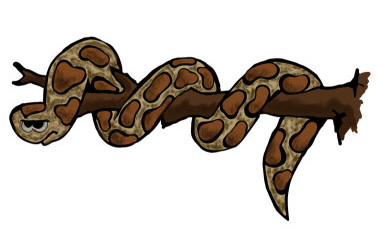Twenty foot, 200-pound serpents that rule the jungle—it sounds like the stuff of nightmares, but only a stretch down the peninsula, they exist in the thousands. Invasive pythons have become something of a Florida phenomenon.
Every few months, news of them pop up in national newspapers, with headlines that say things like “Python Swallows Deer in the Everglades,” or “18-Foot-Long Monster Snake Caught in Florida.” They got so out of hand that in 2013, Florida wildlife officials announced an open python-hunting season. Almost 1,600 amateur and professional hunters came from all over the U.S. to try their hand at hunting this species, spawning a reality TV show and even a video game.
Invasive pythons can have devastating effects on the native species in the Everglades. Of particular concern, according to the National Park Service (NPS), are already protected species, like the American alligator and the Key Largo wood rat. This is not all that has been found in the stomach of an invasive snake—species like bobcats, House Wrens, Limpkins and White Ibises are also in danger.
According to science teacher Jonathan Gray, the snakes are “the largest invasive animal to have established a naturalized habitat anywhere in the United States.”
The numbers of other animals in the Everglades reflect the havoc the huge snakes are wreaking. Scientists recorded sightings of certain animals in South Florida, and found a drastic decline in the populations between the mid 1990s and 2003-2011. The sightings fell steeply: 99.3% fewer raccoons, 98.9% fewer opossums and 87.5% fewer bobcats.
The invasive pythons are primarily Burmese pythons that spread to the Everglades through the exotic pet trade. Although this is all that is officially said of the matter, many biologists point to a hair-raising 1992 incident; Hurricane Andrew destroyed a reptile facility and released almost a thousand Burmese pythons into the wilderness.
The exact number of Burmese pythons in the Everglades is hard to pinpoint. Biologists and park officials put the number at anywhere between 3,000 and 117,000 snakes. Shawn Heflick, a biologist and host of the National Geographic show Python Hunters, explains why all the numbers are simply speculation.
“[T]he problem is that a range that size is no better than just guessing,” he said. “Based on my field experience there, I believe populations are closer to the 10,000 mark than the extreme [over] 100,000.”
This raises the question of whether the Everglades will ever be free of the invasive snakes—and the outlook is not optimistic.
According to a news release from the NPS, “the odds of eradicating an introduced population of reptiles once it has spread across a large area are very low, pointing to the importance of prevention, early detection and rapid response to new invasions.”
Heflick concurs.
“The only way pythons will ever be gone from the everglades is if Mother Nature wipes them out with severe winters [or] disease.”
Meanwhile, others see potential in the Florida python population. Designers like Camille Zarsky, based in New York City, want to source Florida pythons for use in her luxury handbag line. She plans to eventually source at least 50% of her python skins from Florida.
However, Heflick warns that this, too, will pass.
“Many have tried this,” he says. “The numbers just don’t lend themselves to a large industry.”




